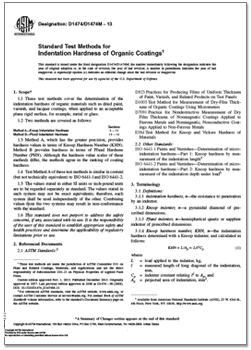英文名称:
ASTM D1474/1474M-13
Standard Test Methods for Indentation Hardness of Organic Coatings
中文名称:
ASTM D1474/1474M-13
有机涂层压痕硬度的标准试验方法
代号说明:
This standard is issued under the fixed designation D1474/D1474M; the number immediately following the designation indicates the year of original adoption or, in the case of revision, the year of last revision. A number in parentheses indicates the year of last reapproval. A superscript epsilon (ε) indicates an editorial change since the last revision or reapproval.
This standard has been approved for use by agencies of the U.S. Department of Defense.
版本说明:
1 These test methods are under the jurisdiction of ASTM Committee D01 on Paint and Related Coatings, Materials, and Applications and are the direct responsibility of Subcommittee D01.23 on Physical Properties of Applied Paint Films.
Current edition approved Nov. 1, 2013. Published December 2013. Originally approved in 1957. Last previous edition approved in 2008 as D1474 – 98 (2008). DOI: 10.1520/D1474_D1474M-13.
2 For referenced ASTM standards, visit the ASTM website, www.astm.org, or contact ASTM Customer Service at service@astm.org. For Annual Book of ASTM Standards volume information, refer to the standard’s Document Summary page on the ASTM website.
3 Available from American National Standards Institute (ANSI), 25 W. 43rd St.,4th Floor, New York, NY 10036, http://www.ansi.org.
标准正文:
1. Scope
1.1 These test methods cover the determination of the indentation hardness of organic materials such as dried paint, varnish, and lacquer coatings, when applied to an acceptable
plane rigid surface, for example, metal or glass.
1.2 Two methods are covered as follows:
Sections
Method A—Knoop Indentation Hardness 6 – 12
Method B—Pfund Indentation Hardness 13 – 19
1.3 Method A, which has the greater precision, provides hardness values in terms of Knoop Hardness Number (KHN). Method B provides hardness in terms of Pfund Hardness Number (PHN). Although the hardness value scales of these methods differ, the methods agree in the ranking of coating hardness.
1.4 Test MethodAof these test methods is similar in content (but not technically equivalent) to ISO 6441-1and ISO 6441-2.
1.5 The values stated in either SI units or inch-pound units are to be regarded separately as standard. The values stated in each system may not be exact equivalents; therefore, each system shall be used independently of the other. Combining values from the two systems may result in non-conformance with the standard.
1.6 This standard does not purport to address the safety concerns, if any, associated with its use. It is the responsibility of the user of this standard to establish appropriate safety and health practices and determine the applicability of regulatory limitations prior to use.
2. Referenced Documents
2.1 ASTM Standards:
D823 Practices for Producing Films of Uniform Thickness of Paint, Varnish, and Related Products on Test Panels
D1005 Test Method for Measurement of Dry-Film Thickness of Organic Coatings Using Micrometers
D7091 Practice for Nondestructive Measurement of Dry Film Thickness of Nonmagnetic Coatings Applied to Ferrous Metals and Nonmagnetic, Nonconductive Coatings Applied to Non-Ferrous Metals
E384 Test Method for Knoop and Vickers Hardness of Materials
2.2 Other Standards:
ISO 6441-1 Paints and Varnishes—Determination of microindentation hardness—Part 1: Knoop hardness by measurement of the indentation length
ISO 6441-2 Paints and Varnishes—Determination of microindentation hardness—Part 2: Knoop hardness by measurement of the indentation depth under load
3. Terminology
3.1 Definitions:
3.1.1 indentation hardness, n—the resistance to penetration by an indenter.
3.1.2 Knoop indenter, n—a pyramidal diamond of prescribed dimensions.
3.1.3 Pfund indenter, n—hemispherical quartz or sapphire indenter of prescribed dimensions.
3.1.4 Knoop hardness number, KHN, n—the indentation
hardness determined with a Knoop indenter, and calculated as
follows:
KHN = L/A p = L/l2 Cp (1)
where:
L = load applied to the indenter, kg,
l = measured length of long diagonal of the indentation,mm,
Cp = indenter constant relating l2 to Ap , and
Ap = projected area of indentation, mm2 .
3.1.5 Pfund hardness number, PHN, n—the indentation hardness determined with a Pfund indenter, and calculated as follows:
PHN = L/A = 4L/πd2 = 1.27 (L/d2) (2)
where:
L = load/kg applied to the indenter, kg,
A = area of projected indentation, mm2 , and
d = diameter of projected indentation, mm.
在线阅读 免费下载







